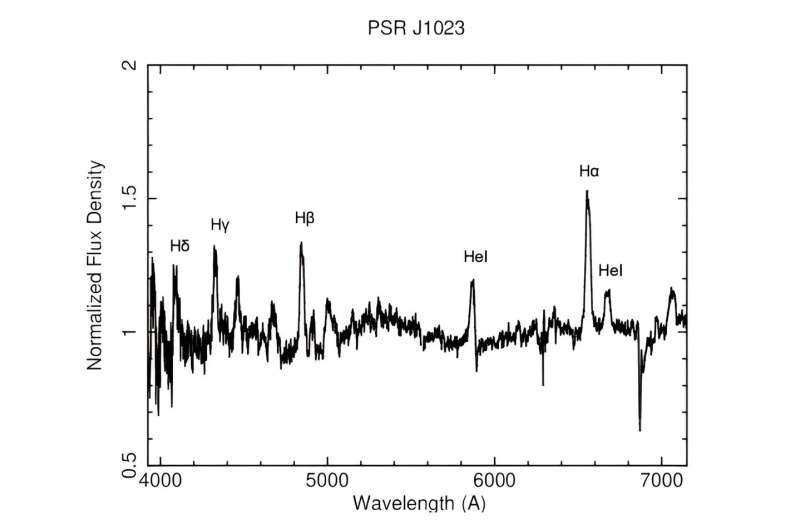
The average spectrum of the J1023 makes it ideal in the release of the continuum. The air flow lines studied in this work are described. Credit: Messa et al., 2024.
Using the Gran Telescopio Canarias (GTC), astronomers from Italy and Spain have made a high-resolution observation of the periodic millisecond variable pulsar named PSR J1023+0038. The result of the monitoring campaign, which was published on September 19 on the publication server arXivprovide important information about the nature of this pulsar.
Pulsars are massive magnetized, volatile neutron stars that emit bursts of electromagnetic radiation. The fastest rotating pulsars, with rotation periods below 30 milliseconds, are known as millisecond pulsars (MSPs). Astronomers think that they are formed in binary systems when the first massive part turns into a neutron star that is turned due to the accretion of material from the second star.
The so-called Transitional millisecond pulsars (tMSPs) exhibit back and forth transitions between the pulsating radio pulsar state (‘pulsar state’) and the state characterized by X-ray pulsations and hard disk characteristics reflected in observations distance (‘disk state). ‘). They are extremely rare, so far only three tMSPs have been identified.
One of them is PSR J1023+0038 (or J1023 for short), which was first discovered two decades ago. Pulsar has a rotation period of 1.69 milliseconds, while its orbital period is about 4.75 hours. The star chip in the system is the previous star version of the G5 model.
Previous observations of J1023 have found that it transitions between an X-ray state and a radio pulsar system supported by rotation. Now, a team of astronomers led by Marco Messa of the University of Milan in Italy has used GTC’s Optical System for Imaging and low-Intermediate-Resolution Integrated Spectroscopy (OSIRIS) instrument to take a closer look at the pulsar’s shape. it is with him. behavior.
The review found that J1023 shows, like other tMSPs, short-term (tens of seconds) changes in all generations. Furthermore, the study found evidence for significant changes in wind line characteristics (equal to full width at half maximum) over a period of minutes. This finding marks the first time when changes in the spectral line characteristics of tMSPs have been detected over such a short period of time.
According to the study, the part of the variation found in the continuum, equal size and full width half, seems to be negative and not connected to each other. This makes the origin of such events unclear.
The observation also found that the Balmer gas line in helium shows in many cases a double-horn gas profile. This suggests the presence of an accretion disk, so J1023 may have remained in its disk state during the observational propagation.
In conclusion, the authors of the paper added that simultaneous multi-wavelength observations should be made to investigate the possible connection between the changes in the characteristics of the wind line and the variable properties in J1023.
Other information:
MM Messa et al, Long-term observational observations of the changing millisecond pulsar PSR J1023+0038, arXiv (2024). DOI: 10.48550/arxiv.2409.12893
Journal information:
arXiv
© 2024 Science X Network
References: An observation exploring the transitional nature of the millisecond pulsar PSR J1023+0038 (2024, September 28) Retrieved 29 September 2024 from https://phys.org/news/2024-09-explore-nature-transitional-millisecond-pulsar.html
This document is subject to copyright. Except for any legitimate practice for study or personal research purposes, no part may be reproduced without written permission. This content is provided for informational purposes only.
#Observations #investigate #nature #rotating #millisecond #pulsar #PSR #J10230038